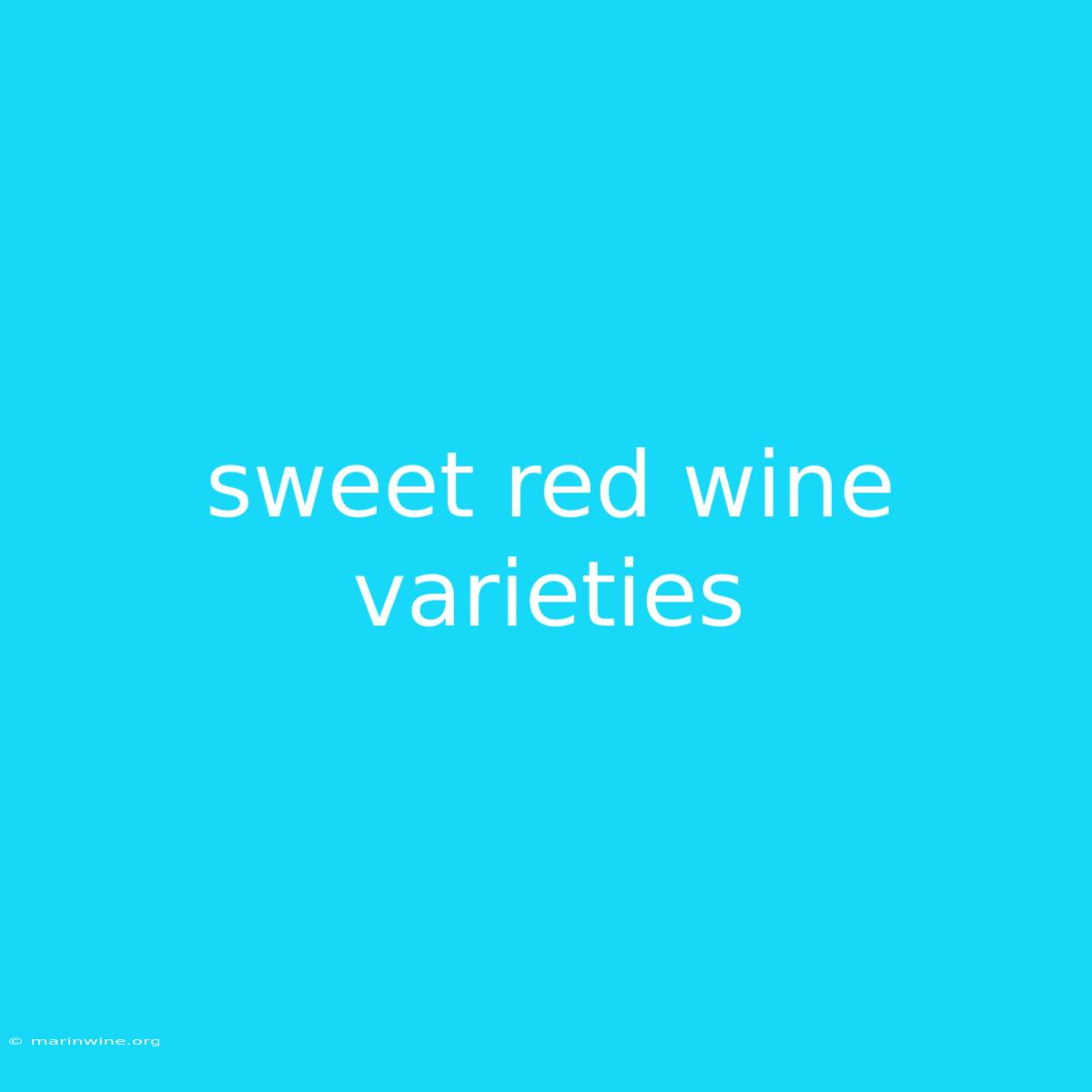Unveiling the Delights of Sweet Red Wine: A Guide to Varietals that Delight the Palate
Have you ever wondered what makes a sweet red wine so irresistible? The answer lies in the intricate interplay of grape varieties, winemaking techniques, and a touch of magic. This article delves into the world of sweet red wines, exploring some of the most beloved varieties that tantalize taste buds with their luscious sweetness.
Why It Matters: Sweet red wines offer a captivating alternative to dry wines, appealing to those who enjoy a touch of sweetness in their beverages. Their versatility allows them to be enjoyed on their own, paired with desserts, or even alongside savory dishes for an intriguing flavor contrast.
Key Takeaways of Sweet Red Wine
| Aspect | Description |
|---|---|
| Sweetness Level | Ranges from slightly sweet to intensely luscious, often categorized as "off-dry," "medium sweet," or "sweet." |
| Fruit Profile | Typically showcases ripe fruit flavors like cherry, raspberry, plum, blackberry, and sometimes hints of spice or chocolate. |
| Body and Texture | Can vary from light and refreshing to full-bodied and rich, often exhibiting velvety tannins that balance the sweetness. |
| Region | Sweet red wines are produced globally, with renowned examples coming from regions like Italy, France, Spain, Portugal, Germany, and Australia. |
Exploring the World of Sweet Red Wine Varieties
1. Lambrusco (Italy)
Introduction: Lambrusco, a sparkling red wine originating from the Emilia-Romagna region of Italy, is known for its vibrant fruitiness and playful bubbles.
Key Aspects:
- Varietal: Lambrusco is made from a variety of grapes including Lambrusco Salamino, Lambrusco Grasparossa, and Lambrusco Sorbara.
- Flavor Profile: Exhibits vibrant notes of red berries, cherry, and sometimes a hint of bitterness from the grape skins.
- Style: Can range from dry to semi-sweet, often with a light, refreshing body and a delicate mousse.
- Pairing: Pairs well with cured meats, pizzas, and light pasta dishes.
2. Brachetto d'Acqui (Italy)
Introduction: Brachetto d'Acqui, a sweet sparkling red wine from the Piedmont region of Italy, offers a delightful balance of sweetness and aroma.
Key Aspects:
- Varietal: Made solely from the Brachetto grape.
- Flavor Profile: Characterized by intense aromas of rose petals, strawberries, and raspberries.
- Style: Known for its bright, fruity sweetness and delicate bubbles.
- Pairing: Exceptional with desserts, particularly those with berries or chocolate.
3. Port (Portugal)
Introduction: Port, a fortified wine from the Douro Valley of Portugal, is a true icon of sweetness and complexity.
Key Aspects:
- Varietal: Made from a blend of grapes, including Touriga Nacional, Tinta Roriz, and Tinta Barroca.
- Flavor Profile: Ripe black fruits, dried figs, chocolate, and spice, with a rich, velvety texture.
- Style: Available in a range of styles, from Ruby Port, characterized by its youthful fruitiness, to Tawny Port, known for its nutty and oxidative character.
- Pairing: Excellent with cheese, chocolate, and nuts, or enjoyed on its own as a dessert wine.
4. Banyuls (France)
Introduction: Banyuls, a fortified sweet red wine from the Roussillon region of France, showcases the intriguing interplay of sweetness and aging.
Key Aspects:
- Varietal: Primarily Grenache, with other varieties like Mourvèdre and Syrah added for complexity.
- Flavor Profile: Offers a rich tapestry of flavors, including dried fruits, plums, figs, and spices, with an elegant oxidative character.
- Style: Aged in oak barrels, developing complex aromas and a smooth, balanced sweetness.
- Pairing: Pairs beautifully with foie gras, cheeses, and chocolate desserts.
5. Late Harvest Riesling (Germany)
Introduction: Riesling, a white grape variety renowned for its versatility, can also be used to produce delicious sweet red wines.
Key Aspects:
- Varietal: Riesling is the primary grape used for these wines.
- Flavor Profile: Combines vibrant fruit flavors of apricot, peach, and citrus with honey, quince, and spice notes.
- Style: The sweetness of late-harvest Riesling wines is derived from the grapes' concentrated sugars, resulting in a balanced sweetness and refreshing acidity.
- Pairing: Excellent with spicy Asian cuisine, fruit tarts, and foie gras.
6. Pinot Noir (France & Others)
Introduction: Pinot Noir, the classic grape of Burgundy, can also be crafted into delicious sweet red wines.
Key Aspects:
- Varietal: Pinot Noir is the sole grape used for these wines.
- Flavor Profile: Often exhibits vibrant red fruit flavors, such as cherry and raspberry, with a delicate sweetness and earthy notes.
- Style: Can range from lightly sweet to intensely luscious, depending on the winemaker's approach.
- Pairing: Pairs well with roasted meats, cheeses, and fruit-based desserts.
Sweet Red Wine: A Journey of Taste
Sweet red wines offer a world of exploration, each variety captivating the palate with its unique personality and flavor profile. From the playful bubbles of Lambrusco to the opulent richness of Port, these wines offer a delightful escape into the realm of sweetness. Whether you prefer a refreshing sparkler or a complex, aged dessert wine, there's a sweet red wine variety waiting to be discovered.

